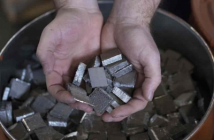Mumbai: Mobilising deposits proving stressful than recovering stressed assets. The Banking industry is facing tough times. The amount lent by banks is around 75% of their deposits. The NPA levels are within four percent of total loans. As such, provisioning for NPAs is far less than the interest paid on deposits. With booming stock markets, real estate deals, and the launch of CBDC, the captivation of deposits has become a challenge. Interest rates on term and savings deposits are shooting up. The vanishing deposits are threatening the viability of operations.
Banks knew well the addresses of NPA accounts to go for recovery. It is proving challenging to find the address of a new depositor of high net worth as the walls of stock exchanges are significant obstacles. Only the weak-hearted and retired people adore the orthodox bank deposits now. A glamorous CBDC will further dent the position as public CASA will flow into this RBI currency, draining the banks further.
Bank treasuries are burning the midnight oil to ensure the depositors return. But the cost and effort are stupendous. Boards are reworking customer service strategies. The media is making big profits out of multiple bank announcements for increased interest rates on deposits. Some banks have rediscovered the value of safe deposit lockers and are marketing the same as tools for fresh deposit mobilisation!
The situation is worse for private sector banks with little CASA and low investments in government securities. The lure for credit is so strong that even a comparatively new bank like the Bandhan Bank has lent almost Rs.100,000 crore against total deposits of Rs.100,000 crores achieving a 100% Credit Deposit Ratio risking its Net Interest Margin and liquidity.
The pressure on the treasury to raise cheap funds and the new need for bulk deposits is eating out the profits. The stature of banks as lenders is under threat, with little funds to lend to meet the ever-rising credit needs of a galloping economy. The challenge for resources is far more difficult than the latest fight against NPAs.
Banks are themselves responsible for the negative growth in deposits. Their credit grew by over 12% year-on-year for June 2022, the highest in at least three years and nearly twice the growth rate of 5.8% for the same period last year. In contrast, bank deposits grew at 8.3%, according to RBI data. The growth was lower than a growth rate of 10.65% during the last year. Credit growth has outstripped deposit growth, making banks run for deposits at high rates.
Strategically, banks have been slow to raise deposit rates despite the RBI raising the effective policy rate from 3.35% to 4.9%. The weighted average deposit rate rose to 5.07% in May compared to 5.03% in April. The weighted average lending rate has increased to 8.79% from 8.72% over the same period.
The rise in deposit rates should have been proportional, but the slow transmission disparity made the depositor run to invest in gold, real estate and stock markets. The risk-avoiding investors went for National Savings Certificates and various government bonds, which pay higher than banks. Banks are on the wrong foot and face a diminishing bottom line in balance sheets.
Another reason for the shortage of investible funds in the market is the slow growth in wages and employment. The size of an Indian pocket has shrunk due to inflation. The repeated increase in EMIs on loans due to RBI-induced hikes in lending rates has further reduced the funds with the public for retention as banks as deposits.
The credit growth at the industry level of 12-13% could face challenges in the absence of a matching inflow of deposits. As such, the banks must innovate customer delight products like high-rate short-term deposits, low-margin loans against fixed deposit receipts, cheaper loans against the security of cash collaterals of third parties, waiver of folio charges, cheque book charges in accounts with balances above Rs.250,000 and free ATM and Debit cards for savings bank accounts.
Worldwide, deposits became stagnant over three years for banks reducing their flexibility and lending capacity. Nearly one-third of banks find their core deposit growth or the cost of funds as their greatest challenge.
While foot traffic to branch offices had decreased before the pandemic, COVID-19 accelerated the trend. The physical bank locations will continue to impact deposit growth negatively. With rising costs, individuals are spending more and depositing less. Keeping customers informed about competitive interest rates and other financial measures to help counteract the loss of purchasing power during inflationary times is critical.
The absence of incentives and inflation-proof returns to depositors keeps them far from the banking counters, leaving bankers gasping for resources for growth and sustenance. In retrospect, the deliberate slow transmission of the benefit of higher interest rates to depositors by banks is proving a self-goal.
About the author:

Mr. Hargovind Sachdev is an Ex-Banker, GM(Retd) of the State Bank of India. Has over 39 years of experience in banking, having occupied senior positions in UCO Bank, United Bank of India, State Bank of Patiala, State Bank of Travancore & State Bank of India where he headed the Central European Credit Desk at Frankfurt, Germany from 2006 to 2011 covering 15 countries of Central Europe. Has undergone International Banking Training from the Asian Institute of Management, Manila, Philippines in the Year 2003 and a Multi-currency lending-technique training at the Euro Money Institute, London in 2009.
He has specialisation in Credit, Foreign Exchange, Vigilance, Monitoring & appraisal of Corporate Loans, MSME Credit, Gold Loans, Agricultural Loans & NRI Business Management in assets & liabilities. As a Forensic Auditor, he has conducted various Transaction Audits allotted by Banks.
He was felicitated by the Central Vigilance Commissioner, Sh. C.V Chowdhry for winning first prize for best article on Preventive Vigilance in 2015. He is also an accomplished Public Speaker having conducted multiple Motivational Seminars for institutions like ONGC, National Housing Bank & Bank of Baroda. He is an Independent Director & consultant to various big entities in the corporate sector at present.





